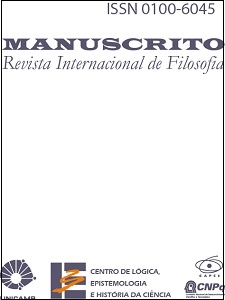Resumo
In this paper, we provide a new formulation of a coherence theory of truth using the resources of the partial structures approach − in particular the notions of partial structure and quasi-truth. After developing this new formulation, we apply the resulting theory to the philosophy of mathematics, and argue that it can be used to develop a new account of nominalism in mathematics. This application illustrates the strength and usefulness of the proposed formulation of a coherence theory of truth.
Referências
ARRUDA, A.I., CHUAQUI, R., and DA COSTA, N.C.A. (eds.). Mathematical
Logic in Latin America. Amsterdam: North-Holland, 1980.
AYER, A.J. (ed.). Logical Positivism. New York: The Free Press, 1959.
BOSANQUET, B. Knowledge and Reality. London: Routledge and Kegan Paul, 1885.
BOURBAKI, N. Theory of Sets. Boston, MA: Addison-Wesley, 1968. Translated from the French edition.
BRADLEY, F.H. Essays on Truth and Reality. Oxford: Clarendon Press, 1914. Reprinted in 1962.
BUENO, O. “Empirical Adequacy: A Partial Structures Approach”. Studies
in History and Philosophy of Science, 28, pp. 585-610, 1997.
———. “What is Structural Empiricism? Scientific Change in an Empiricist
Setting”. Erkenntnis, 50, pp. 59-85, 1999a.
———. “Empiricism, Conservativeness and Quasi-Truth”. Philosophy of
Science, 66 (Proceedings), pp. S474-S485, 1999b.
BUENO, O., and de SOUZA, E. “The Concept of Quasi-Truth”. Logique et
Analyse, 153-154, pp. 183-199, 1996.
CHIHARA, C.S. Constructibility and Mathematical Existence. Oxford: Clarendon Press, 1990.
CHURCHLAND, P.M., and HOOKER, C.A. (eds.). Images of Science: Essays on Realism and Empiricism, with a Reply by Bas C. van Fraassen. Chicago: The University of Chicago Press, 1985.
COHEN, P.J. Set Theory and the Continuum Hypothesis. New York: Benjamin, 1966.
DA COSTA, N.C.A. “A Model-theoretic Approach to Variable Binding Term Operators”. In: A.I. Arruda, R. Chuaqui, and N.C.A. da Costa (eds.) (1980), pp. 133-162.
———. “Pragmatic Probability”. Erkenntnis, 25, pp. 141-162, 1986.
———. Logiques classiques et non classiques: Essai sur les fondements de la logique. Paris: Masson, 1997.
DA COSTA, N.C.A., BÉZIAU, J.-Y., and BUENO, O. “Aspects of Paraconsistent Logic”. Bulletin of the Interest Group in Pure and Applied Logics, 3, pp. 597-614, 1995.
DA COSTA, N.C.A., BUENO, O., and FRENCH, S. “The Logic of Pragmatic
Truth”. Journal of Philosophical Logic, 27, pp. 603-620, 1998.
DA COSTA, N.C.A., and FRENCH, S. “Pragmatic Truth and the Logic of
Induction”. British Journal for the Philosophy of Science, 40, pp. 333-356,
———. “The Model-Theoretic Approach in the Philosophy of Science”.
Philosophy of Science, 57, pp. 248-265, 1990.
———. “Towards an Acceptable Theory of Acceptance: Partial Structures
and the General Correspondence Principle”. In: S. French and H.
Kamminga (eds.) (1993), pp. 137-158.
———. Science and Partial Truth: A Unitary Approach to Models and Scientific Reasoning. Oxford: Oxford University Press, 2003.
FIELD, H. Science without Numbers: A Defense of Nominalism. Princeton, N.J.: Princeton University Press, 1980.
———. Realism, Mathematics and Modality. Oxford: Basil Blackwell, 1989.
FLANNAGAN, T.B. “On an Extension of Hilbert’s Second ε-Theorem”.
Journal of Symbolic Logic, 40, pp. 293-397, 1975.
FRENCH, S., and KAMMINGA, H. (eds.). Correspondence, Invariance and
Heuristics: Essays in Honour of Heinz Post. Dordrecht: Reidel, 1993.
FUHRMANN, A. An Essay on Contraction. Stanford: CSLI Publications,
GILLIES, D. Philosophy of Science in the Twentieth Century: Four Central Themes. Oxford: Blackwell, 1993.
GUILLAUME, M. “Sur une propriété remarcable du système de Bourbaki”.
Comptes Rendus de l’Académie des Sciences de Paris, 250, pp. 1776-1777, 1960.
———. Recherches sur le symbole de Hilbert. Thèse, Clermont-Ferrand, France, 1964.
HAACK, S. Evidence and Inquiry. Oxford: Blackwell, 1993.
HELLMAN, G. Mathematics without Numbers: Towards a Modal-Structural Interpretation. Oxford: Clarendon Press, 1989.
———. “Structuralism without Structures”. Philosophia Mathematica, 4, pp. 100-123, 1996.
HILBERT, D., and BERNAYS, P. Grundlagen der Mathematik. Berlin:
Springer. Vol. I (1934) and vol. 2 (1939).
LEISERING, A.C. Mathematical Logic and Hilbert’s ε-symbol. London: MacDonald, 1969.
MALAMENT, D. “Review of Field [1980]”. Journal of Philosophy, 79, pp. 523-534, 1982.
MIKENBERG, I., DA COSTA, N.C.A., and CHUAQUI, R. “Pragmatic
Truth and Approximation to Truth”. Journal of Symbolic Logic, 51, pp.
-221, 1986.
NEURATH, O. “Protokollsätze”. Erkenntnis, 3, pp. 204-214, 1932-1933. (An English translation can be found in A.J. Ayer (ed.) (1959), pp. 199-
)
NOVAK, I.L. “Construction of Models for Consistent Systems”. Fundamenta Mathematica, 37, pp. 87-110, 1951.
PUTNAM, H. “Mathematics without Foundations”. Journal of Philosophy, 64, pp. 5-22, 1967.
———. “Realism and Reason”, 1976. In: H. Putnam (1978), pp. 123-140.
———. Meaning and the Moral Sciences. London: Routledge and Kegan Paul, 1978.
———. “Models and Reality”. Journal of Symbolic Logic, 45, pp. 464-482, 1980.
RUSSELL, B. The Problems of Philosophy. Oxford: Oxford University Press, 1912.
SHAPIRO, S. “Modality and Ontology”. Mind, 102, pp. 455-481, 1993.
SHOENFIELD, J.R. Mathematical Logic. Reading, MA: Addison-Wesley Publishing Company, 1967.
VAN FRAASSEN, B.C. The Scientific Image. Oxford: Clarendon Press, 1980.

